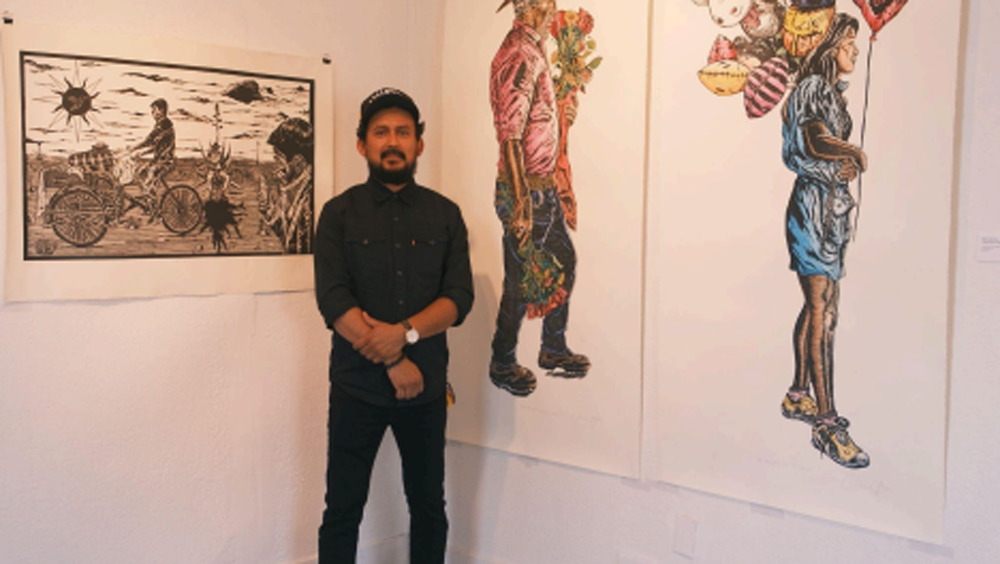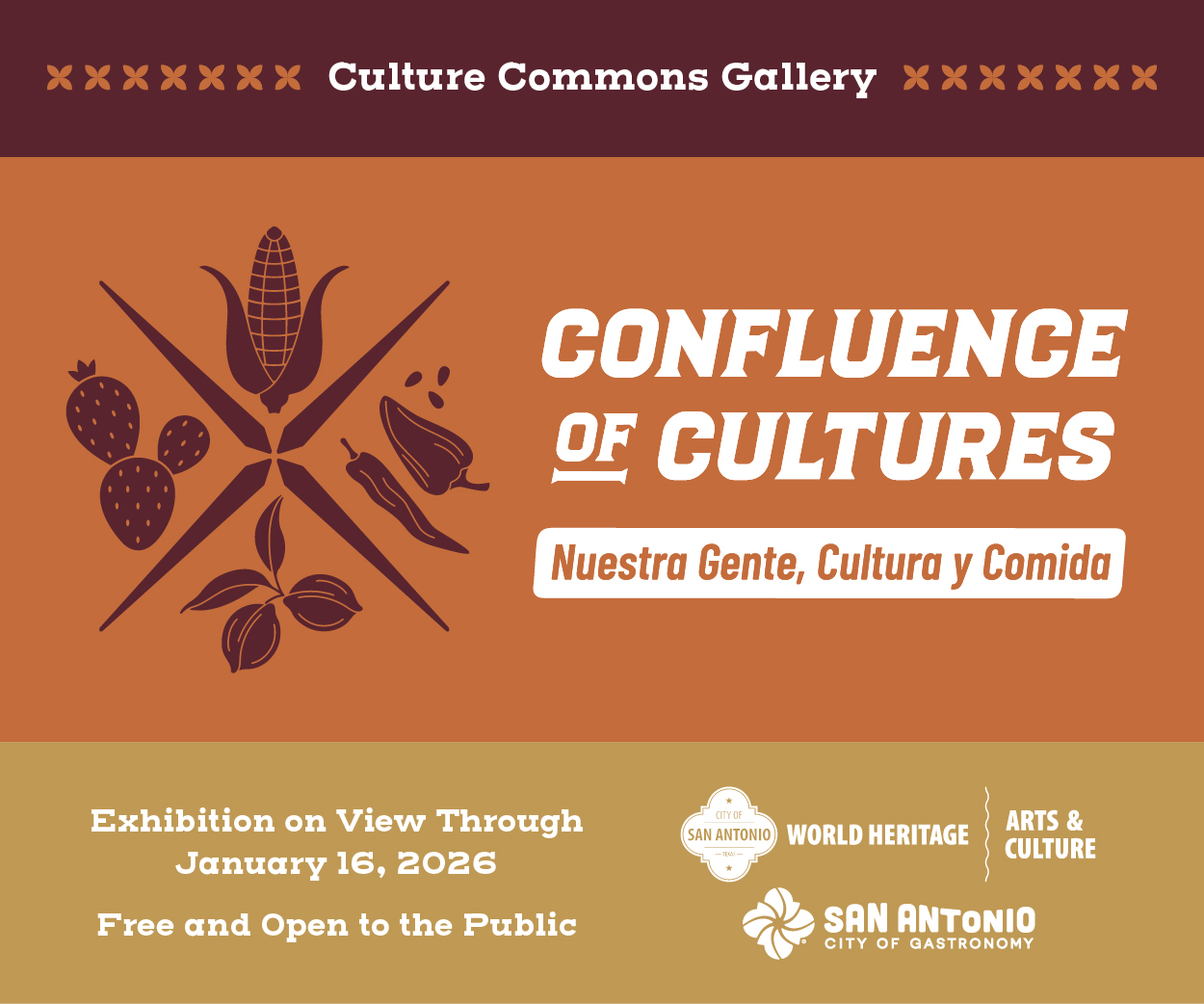Borderland artist Marco Sanchez opened his first solo exhibit, Miscelánea Fronteriza at Presa House on First-Friday, June 7. Sanchez is a full-time art educator and artist but also works with community activists concerned with the compelling border issues of his community. His solo show curated by Rigo Luna focuses principally on immigration but also captures the everyday life of residents on both sides of the U.S.-Mexico borderlands.
El Paso, Texas is one of the nation’s epicenters for border migration. The migration patterns of previous decades have been disrupted as migrants crossing the border coming from Africa, Asia, and the Western Hemisphere represent the majority of new migrants. In recent years Mexico’s drug cartels have turned to extortion and smuggling, driving a greater number of rural families toward seeking asylum in the U.S. According to The New York Times “In the first eight months of the 2024 fiscal year, the Border Patrol apprehended nearly 150,000 Mexican migrant families entering the United States illegally, compared with 87,014 in 2023 and 17,040 in 2020.”
El Paso has become a major hub for migrants who arrive in Texas, but they are transported within days to other U.S. states and major cities. Last week the Biden-Harris Administration imposed stricter migration policies that closed the border to most asylum seekers. The new policies are a response to a surge in migration of families from Central America, Haiti, and Cuba.
It is nearly impossible to live in El Paso and not be aware or touched by the daily stream of migrants entering the city. Misguided immigration policies such as the separation of children from their families struck a raw nerve with many borderland residents. Marco Sanchez recalls the anger he felt in the initial years of the Trump administration when the president referred to Mexicans as “rapists” and “drug dealers.” Sanchez witnessed the migrant families and many women and young children gathering at the local El Paso Catholic church and knew better. He told me his art reflected honest reality and compassion for those struggling along the U.S.-Mexico border.
Sanchez grew up in Cuidad Juarez, Mexico, and moved to El Paso at age 11 with his parents Miguel and Guillermina Sanchez. He is the eldest of four children. His father brought the family to El Paso seeking a better life. A carpenter by trade, Miguel Sanchez found work in construction and built a small company assisted by his son Ivan. Marco’s sister Mariana, the second oldest, works in family reunification in Greensboro, N.C., finding ways to help parents and children who have separated in the migration process. His other brother Israel is a nurse and about to start his M.D. studies at the University of Arizona.
Marco Sanchez graduated from El Paso’s Franklin High School in 2001 and worked as a bartender for a dozen years before seriously considering becoming an artist. Sanchez enjoyed traveling and while returning from a trip to South America, he stopped to see his grandfather Guillermo Cordero Enriquez in Michoacan. Enriquez had studied art at the prestigious San Carlos Academy where Diego Rivera, David A. Siqueiros, and Jose Clemente Orozco studied. Sanchez marveled at his grandfather’s artistic painting talent and printmaking skills and began to think seriously about a career as a painter and printmaker.
In 2009 Marco Sanchez enrolled in art classes at El Paso Community College [EPCC]. He had always had a talent for drawing but learned about painting and printing when he enrolled at the University of Texas El Paso
[UTEP]. He credits UTEP art professor Francisco Delgado as an important mentor and significant influence in his artistic development. Following his studies at UTEP, Sanchez enrolled at Edinboro University in Pennsylvania and earned an MFA in Printmaking.
Sanchez is an art professor at El Paso Community College where he teaches Printmaking, Life Drawing, Drawing I, and Art Appreciation. He is the
Founder/Director of Taller La Espina in El Paso and a Mellon Foundation Fellow in partnership with UTEP and EPCC. He participated in art residencies throughout Mexico, including Mexico City, Michoacan, Oaxaca, and Queretaro.
College art programs expect their professors to establish a solid record in research or exhibition. Sanchez has exceeded all expectations. He contributed to international art exhibits sponsored by the Mexican Consulate Office that opened in Mexico City and traveled to numerous U.S. cities. He was part of the 2023 Soy Se Tejas exhibit at the Centro de Artes Museum in San Antonio. The exhibit is currently on view at Arts Fort Worth through June 22 and has garnered positive national reviews.
Sanchez refers to his artistic odyssey as Miscelánea Fronteriza [Border Miscellaneous]. He seeks to “illustrate the vibrant life of the border using its flora, fauna, and the resiliency of the people who live, pass through, and are in pursuit of a better life.” Sanchez’s analysis of life on the border is enhanced by his photography which he utilizes to capture certain images he wishes to illustrate in his prints and paintings later in his studio. He explained that he found such an image in the street vendor pushing an ice cream cart in El Paso. His print shows the vendor walking through the barrio and a young boy enjoying a raspa snow cone.
While traveling throughout Mexico Sanchez witnessed the constant movement of people walking on the road, boarding trains, and sitting behind the bed of trucks. His powerful print, “Peregrinaje Con La Bestía,” depicts a scene where young travelers cling to a train car while other migrants reach out to help others board.
Marco Sanchez paints from his experiences and understanding of life on both sides of the U.S.-Mexico border. In graduate school, Sanchez bought a large
Oaxacan printing press capable of printing unusually long six-foot prints. An El Paso company commissioned Sanchez to make two prints with Mexican themes for its new corporate office. Sanchez completed “Aliento a Flores” and “Vendedora de Globos.”
His “Aliento a Flores,” a relief print with watercolor hand embellishment is a beautiful rendition of a flower vendor commonly seen in barrio communities across the Southwest. The “Vendedora de Globos,” also a relief print with watercolor hand embellishment, portrays a woman selling balloons, something more common in border towns or Mexican cities especially in Chapultepec Park in Mexico City.
Marco Sanchez’s exhibit Miscelánea Fronteriza is open by appointment only and closes on June 29th. Art lovers interested in the borderlands, Mexican culture, and current topics of immigration should take time to view these stunning prints.
Marco Sanchez: Borderland Artist, Educator, and Printer Captures the Border Frontier







